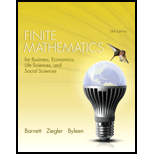
In Problems 15 and 16, find the limiting matrix for the indicated standard form. Find the long-run probability of going from each nonabsorbing state to each absorbing slate and the average number of trials needed to go from each nonabsorbing state to an absorbing state.
Want to see the full answer?
Check out a sample textbook solution
Chapter 9 Solutions
Finite Mathematics for Business, Economics, Life Sciences, and Social Sciences (13th Edition)
Additional Math Textbook Solutions
Algebra and Trigonometry (6th Edition)
Elementary Statistics (13th Edition)
University Calculus: Early Transcendentals (4th Edition)
Thinking Mathematically (6th Edition)
Elementary Statistics
- 21:46 MM : 0 % sparxmaths.uk/studer Sparx Maths + 13 24,963 XP Andrey Roura 1A ✓ 1B X 1C 1D Summary Bookwork code: 1B 歐 Calculator not allowed Write the ratio 3 : 1½ in its simplest form. 32 Menuarrow_forwardPLEASE SOLVE STEP BY STEP WITHOUT ARTIFICIAL INTELLIGENCE OR CHATGPT SOLVE BY HAND STEP BY STEParrow_forward2.- Solve the following Homogeneous Differential Equation (xy + 3y²+x²)dx − (x² + 2xy)dy = 0 -arrow_forward
- Write a Regression summary explaining significance of mode, explaining regression coefficients, significance of the independent variables, R and R square. Premiums earned Net income Dividends Underwriting Gain/ Loss 30.2 1.6 0.6 0.1 47.2 0.6 0.7 -3.6 92.8 8.4 1.8 -1.5 95.4 7.6 2 -4 100.4 6.3 2.2 -8.1 104.9 6.3 2.4 -10.8 113.2 2.2 2.3 -18.2 130.3 3.0 2.4 -21.4 161.9 13.5 2.3 -12.8 182.5 14.9 2.9 -5.9 193.3 11.7 2.9 -7.6arrow_forward1. Show that the vector field F(x, y, z) = (2x sin ye³)ix² cos yj + (3xe³ +5)k satisfies the necessary conditions for a conservative vector field, and find a potential function for F.arrow_forward1. Newton's Law of Gravitation (an example of an inverse square law) states that the magnitude of the gravitational force between two objects with masses m and M is |F| mMG |r|2 where r is the distance between the objects, and G is the gravitational constant. Assume that the object with mass M is located at the origin in R³. Then, the gravitational force field acting on the object at the point r = (x, y, z) is given by F(x, y, z) = mMG r3 r. mMG mMG Show that the scalar vector field f(x, y, z) = = is a potential function for r √√x² + y² . Fi.e. show that F = Vf. Remark: f is the negative of the physical potential energy, because F = -V(-ƒ).arrow_forward
 Linear Algebra: A Modern IntroductionAlgebraISBN:9781285463247Author:David PoolePublisher:Cengage Learning
Linear Algebra: A Modern IntroductionAlgebraISBN:9781285463247Author:David PoolePublisher:Cengage Learning
 College AlgebraAlgebraISBN:9781305115545Author:James Stewart, Lothar Redlin, Saleem WatsonPublisher:Cengage Learning
College AlgebraAlgebraISBN:9781305115545Author:James Stewart, Lothar Redlin, Saleem WatsonPublisher:Cengage Learning


